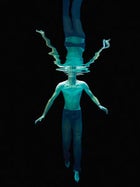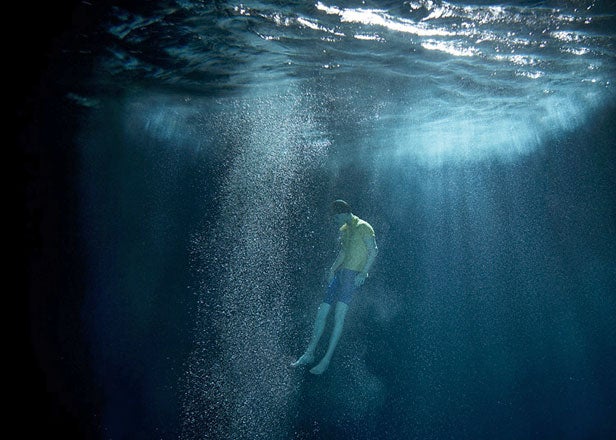AT 5 P.M. ON A GRAY MONDAY night, as I ride a whirring elevator alone to the fourth floor of 148 West 23rd Street, in Manhattan's Chelsea neighborhood, I can't help but suffer doubts.
sensory deprivation
 Floating
Floating╠ř
Earlier, the idea of spelunking around in my own consciousness for an hour or so had sounded like a great adventure. But now, as I'm about to enter the lightless, soundless realm of Blue Light Floatation's sensory-deprivation tank, I worry that I might be swan-diving into a black hole.
I rap on a door toward the end of a long, carpeted hallway and am met by proprietor Sam Zeiger, a fifty-something guy with the perfect posture and pale skin of someone who's spent a lot of time lying in the dark.
“Hi, Eric,” he says quietly, ushering me inside. BLF, one of the tri-state area's eight commercial “flotation centers,” turns out to be housed in Sam's tiny apartment.
To my right, a jangly bead curtain obscures the entrance to a small kitchen. To my left, there's a fifties-style white-tiled bathroom. At the end of a narrow hallway, past a folding tatami screen, is a living room covered with Sam's own pencil drawingsÔÇöportraits, mostly, heavy on gurus, with a couple of faces from The Godfather thrown inÔÇöand lined with shelved paperbacks ranging from The Book of Floating: Exploring the Private Sea to LSD: My Problem Child. The hulking structure at the end of the hall? I initially mistake it for a storage closet, but it's actually the tank room.
We step inside, and Sam slides open another door, behind which sits the tank. Unlike the coffinish and low-slung tanks you'll see at most flotation centers, Sam's custom-built, $25,000 model resembles an oversize bathtub. It's eight feet long and four feet wide, with a six-foot ceiling, and, thankfully, has a simple sliding panel in lieu of the traditional (locking) metal hatch.
So I'll lie down in this soundproof, lightproof enclosure, floating on a bed of supersaturated salt water kept at 93.5 degreesÔÇömy skin temperatureÔÇöand . . . what?
“The most important part is that it's your experience,” says Sam. “I don't want to say what's going to happen, because I don't want to interfere.”
He explains the pre- and post-float practicalities, the most important of which, I gather, is to not drip water on his floor. Fifteen minutes later, I strip naked, rinse in the shower across the hall, dry off, pad back to the tank wrapped in a towel, drop it, and lie down in warm, slimy brine. Then I click off the light.
Reality goes black. I float so high that my ears are barely submerged, and I gulp mouthfuls of air as humid as jungle mist. It's freaky at first, but I calm down and perform a couple of experiments. Is the water so floaty that I can raise my head without sinking? Yes. What about legs and arms simultaneously? Yes. With jazz hands? Cool!
Once the tiny waves subside, my body finds its natural state of repose: cattywampus, with arms above my head in a tangle and neck kinked to the side. This isn't so bad, I think, except that I never should have bad-mouthed yoga. I must look like a seizure victim.
LIKE CHAKRA TUNE-UPS, hilltop Zen retreats, or the “laying on of hands” by a Reiki master, sensory deprivation was something I hardly understood but confidently dismissed anyway. A return to the womb? Been there, thanks. But my friend Dave, who lives alone in a cabin in the woods, was insistent, blurting out “sensory deprivation tank!” in practically every conversation we'd had lately. Crude, sure, but apparently also effective, and one night I finally began looking into the subject.
There are some 60 commercial sensory-deprivation-tank centers scattered across the U.S. They often have cuddly names: Drift and Dream, iFloat Spa, Zoe's Abundant Life Float Tank. Most are single-tank operations, like Sam's, but a few are sci-fi-esque multi-tank affairs, like SpaceTime Tanks in Chicago. Patrons range from stockbrokers to Nag ChampaÔÇôscented fans of the occult. Most people float for an hour, though someÔÇö”long floaters”ÔÇöwill stay for two or three.
As Sam so wisely told me, your experiences in a tank may vary. Some practitioners view their floats as rejuvenating spa treatments, nothing more. Others have crazy visions that spur creativity. Then there are those, such as the founder of Lazy Yoga Flotation in Las Vegas, who consider floats to be nothing less than a shortcut to enlightenment.
Ex-junkies are especially fervent proselytizers. Craig “Crash” Hoefler, a former LSD user and creator of Venice Beach, California's Float Lab, claims (without a trace of irony) to be building “the ultimate sensory-deprivation tank”ÔÇöcomplete with a 26-inch flatscreen TV and two 1,600-watt underwater speakers. The only thing that people agree on is that the 1980 movie Altered States is an overdramatization; I would not, like the main character, enter a sensory-deprivation tank a man and exit a sheep-devouring ape.
There's definitely a serious side to all this, perhaps even a frightening side. A British study published last year in The Journal of Nervous and Mental Disease found that when 19 healthy individuals were each placed in a simple room devoid of light and sound for just 15 minutes, many of them displayed symptoms of psychosis. Two felt an “evil presence.” Eleven reported seeing hallucinations of faces or objects.
Sign me up! I've explored the dustiest nooks of Asia, canoed down labyrinthine Amazonian rivers, trekked to ghost towns in the Alps. Who knows? Perhaps taking a warm bath will turn out to be the strangest trip of all.
BACK IN THE TANK, after my initial skittishness, I try to quiet my mind.
“Very often people come with the idea of leaving the body,” Sam had said, “but to achieve a deeper state of consciousness, it's most important to first get into your body.”
So I get into my body. And it feels gross and awkward. Every heartbeat reverberates like a timpani. My eyelashes make a swishing noise when I open and close my lids. Ligaments in my neck crunch and crackle. I'm an old man, I think. But I'm not an old manÔÇöI'm just myself, floating freely … above the city.
It all feels very real. I'm a floating blob, able to look down and see shoppers staring in the windows of furniture stores, my buddy Chris striding along purposefully with his orange messenger bag.
“Wow, you're really getting into it,” someone says. It's the voice of my wife, Hrund. “You're really going deep.”
“I am going deep,” I say.
And then another unexpected sound crashes inside my head: electronic New Age music!
Unfortunately, that part is real. Sam has turned on the speakers, his signal that the session is ending. After drying off and getting dressed, I book an hour-and-a-half session for the following week and bolt out the door, barely touching the glass of herbal tea that Sam has put out.
DID I JUST FALL ASLEEP and dream? Probably. It's hard to say when you don't know if your eyes are open or shut or which way is up.
It's possible I was awake, or somewhere in between, in some off-Broadway theater of the subconscious. In any event, it felt like an altered state, the sort of thing yogis induce by focusing their concentration on a pebble or that mountaineers experience after starving themselves of oxygen. And that's precisely what some floaters are after.
“In otherwise well-adjusted people,” says Oliver Mason, a senior lecturer in clinical psychology at University College London and author of a recent sensory-deprivation study, “all hallucinations are the result of abnormal circumstances.” Whether you're being mesmerized by white lines on the highway (“highway hypnosis”) or think you're seeing banana slugs when you aren't, the underlying mechanism is the same: the mind, either overwhelmed or dramatically understimulated, confuses inner signals with information gathered by the five senses.
Exactly how this happens in the brain is poorly understood, but such cognitive mistakes can appear to be very real. “If you think the sound of a word comes from your head, it's a thought,” says Mason. “If you think it came from the outside, it's a voice.”
“So hallucinations are just silly mistakes in the head?” I ask.
“Why would they be silly?” he says. “Significance is only constructed in the brain. With an experience in an altered state, the key question is, Does the significance carry over into one's daily life?”
SO FAR, THE MOST concrete carryover from my first tank experience is salt. Having showered too hastily, I spend the following three days digging massive wax-encrusted crystals out of my ears. Even so, I'm still curious to see what will happen when I go “deeper.”
Returning to Blue Light on a Thursday at 5:30, I find that Sam was not at all offended by my previously abrupt departure. “Sometimes you just need time to sit with yourself,” he says. “Process.”
Time for my next dunk. Off go the clothes. Whoosh goes the shower. I close the tank door and settle into the peaceful darkness, ready for all to be revealed.
Which, of course, it isn't. The mind is not, as the old clich├ę goes, “an excellent servant but a terrible master.” It's just an unruly bastard, and mine refuses to call forth any visions of shamanic significance.
Instead, I pay $100 to fidget and ruminate about all the things I've been meaning to do, like trimming my toenails, or returning that book I've had for six months, the one about building small sailboats.
Later, my friends at the coffee shop are extremely let down to hear that my mind didn't collapse like a high-altitude souffl├ę. Their teasing doesn't faze me, though. With Sam's cautious approval, I schedule a four-hour float. Four hours is long enough to qualify me as a “long floater” and potentially mind-bending enough that, if you lived in the UK, at least, an academic study involving this long a session would require approval from the National Patient Safety Agency. But reading about the tank's creator, John Lilly, I realize that four hours is nowhere near the outer limits of floating.
Lilly, a physician and neurophysiologist, invented the sensory-deprivation tank in 1954, when he was working at the National Institute of Mental Health. Supported by a Cold WarÔÇôera interest in brainwashing, his objective was simple: to isolate and study consciousness. Ten years' worth of floats later, however, his tank studies had fallen out of vogue with serious scientistsÔÇöand he'd turned into a fruit loop. By the mid-sixties he was conducting his “research” in St. Thomas, often after inhaling ketamine or dropping a serious amount of acid.
Inside the metal tank, Lilly believed, he could contact something he called “Alternity,” via a sort of godlike presence he dubbed “the Earth Coincidence Control Office.” He also believed he could communicate with dolphins, and went as far as performing the so-not-cool act of dosing them with LSD.
The closest I get to a drugged-out Flipper state is on Saturday night, when my girl and I watch the rough-stock frenzy that is a Professional Bull Riders event and, afterwards, drink a few too many and stay out till cockcrow. I claw my way to the phone a couple hours later, feeling like a spike has been driven through my head, and call Sam to reschedule.
“I should shut off the filtration system then,” he says in a huff.
“I'm sorry, Sam,” I say. “It's just thatÔÇö”
“I turned people away.”
“I'm happy to pay a portion as a cancellation fee,” I croak.
“I prepared it especially for you,” he replies, sounding injured. What? Did he remove the wetness of the water?
I'm annoyed, but his guilt trip works. I climb out of bed and race to the tank, where I'm sure I'll fall asleep and end up even more dehydrated and starving and hungover.
THINGS START OUT AS USUAL. The boundary between my skin and the water blurs, all sense of time disappears, and my mind starts to project bizarre hallucinations on the formless black, beginning with a Daliesque montage of my recent romantic history. Other visions include a tiny girl in a red rain slicker walking down a beach toward a collection of enormous, threatening shorebirds, maybe sandpipers, and then lying down in a beak curved like an elephant tusk and falling asleep.
And then Napoleon appears. I certainly hadn't expected the emperor of France to show up, but here he isÔÇöwearing riding pants and a shiny-buttoned coat with tails, his thinning wisps of hair slicked to his forehead. He strides across a dirt floor inside Madison Square Garden, climbs atop a small circular stage, and begins belting out a pitch-perfect rendition of Beyonc├ę's saucy hit “Single Ladies (Put a Ring on It).” Then he's gone and, next thing I know, the session is over.
As I exit Blue Light Floatation onto the bustling street, whatever significance the hallucinations had begins to fade fast. There is one major difference, though: I feel amazingly lucid and energetic. Forget a hammock on the beach in Mexico or a morning mimosa in the tart air of St. Moritz. As a hangover cure, sensory deprivation kicks ass.


